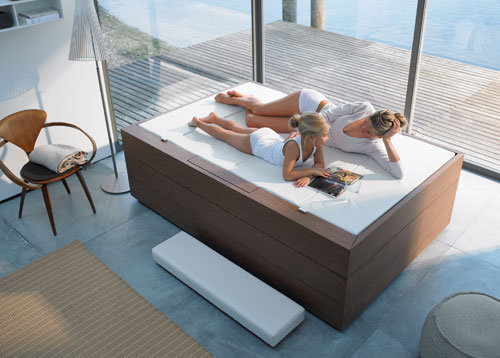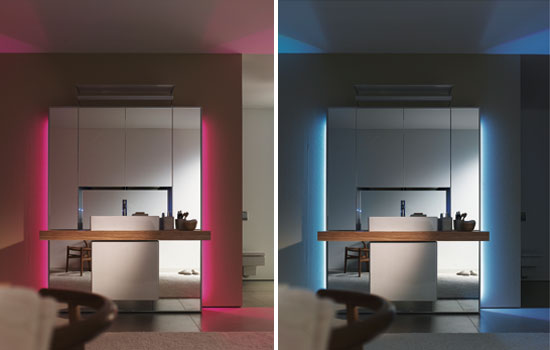Bathroom Fixtures as Furniture
Martin Bergmann from the Vienna-based design trio EOOS applied this living character concept to a soaking tub that could be covered with a useful but elegant upholstered covering when not otherwise being used. “We wanted to give the tub an additional new function so that people could use it in a greater variety of ways” He has helped to develop a fold-out upholstered relaxation deck that covers over a tub and can be used as a piece of furniture for sitting or lounging on. In doing so, he succeeded in creating a vital element that was still missing from a bathroom. “For example, you can quickly make the dirty mountain-biking outfit disappear inside the tub or you can relax on top after taking a bath.” The bathing area thus becomes an ensemble with a wide variety of different uses and the tub “isn't immediately recognizable”. He goes on to point out that “A well-designed bathroom creates new possibilities for everyday use. The individual lives with the bath—even after the ritual bathing experience. At the same time, these functions can also be deliberately linked with the rituals of lying down and relaxing. It's not the designer but the user who decides about the symbolic quality of the bath.”
 |
A soaking or system tub that can be covered and used for other living purposes allows more integration of spaces. Photo courtesy of Duravit USA, Inc. |
As part of the emerging trends in bathroom design, light and color are, as always, dramatically critical. “Light and color are an important element of our quality of life and influence our sense of wellbeing to a high degree” according to Andreas Struppler, a prominent architect and designer from Munich, Germany. This is why he sees light as being the key factor in the dreamlike quality of a bathroom: “In the bathroom, where the day begins and ends, the right light ensures a good start to both the day and the night.” According to the experts, the lighting concept should be designed so that, on a purely functional level first, it provides sufficient support for difficult visual tasks and, at the same time, facilitates orientation for older people and children at night. “Secondly, it has to be able to appeal to the emotions and generate feelings and atmosphere,” says Struppler. The latter, referred to by the designer as “emotional lighting,” is important for ensuring that the day draws gently to a close: “When the lights shine onto the surrounding ceilings and walls and bathe them in a soothing blue, stimulating red, uplifting green or a program with all colors in alternation, the reviving effect of a relaxing bath is stepped up a notch.” For him, the bathroom only excels when light and color interact successfully to create a profusion of color, when every shade creates a different atmosphere.
 |
Lighting can be used to create different moods and enhance the experience of personal space. Photo courtesy of Duravit USA, Inc. |









